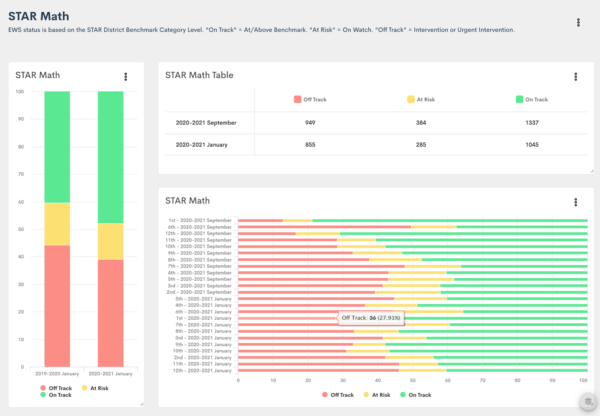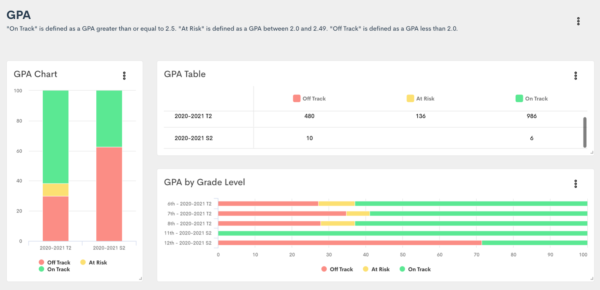Leveraging an Early Warning System within a Data-Driven MTSS
One of the primary goals of Illuminate's suite of products is to allow educators to spend less time wrangling data and more time on the critical decisions that affect student outcomes. As you'll read about below, Sonoma Valley's use of eduCLIMBER and Achievement Dashboard to establish a district-wide Early Warning System (EWS) is a great example of just that.
Not only did Sonoma Valley take advantage of Illuminate's MTSS management and real-time dashboard solutions, but they also took advantage of the valuable services Illuminate offers to support school districts in their work. We relish the opportunity to work hand-in-hand with school districts like Sonoma Valley on big, important projects that make a difference for educators and students. The mission of Illuminate's Consultative Services team is to offer Illuminate districts valuable services and expertise that save educators significant time and effort building assessments, reports, or items and setting up sophisticated systems within our applications.
To facilitate building out an EWS in eduCLIMBER with companion reporting in Achievement Dashboard, Sonoma Valley employed Illuminate's "Advanced Features Setup" service. Working collaboratively with Dr. Charles Wilson, we helped set up an interconnected series of weighted thresholds in eduCLIMBER that automatically identify and tag students as On Track or Off Track in various categories, using numerous data points and multiple criteria. Then, to bring the data to the surface, we worked with Sonoma Valley to build out a series of dashboards in Achievement Dashboard.
I’m grateful for the opportunity to work with Dr. Wilson and Sonoma Valley, and we're thrilled that Dr. Wilson is willing to share this work with the Illuminate community.
Sincerely,
Franck Reyherme
Director of Data Visualization Services
Illuminate Education
***
Leveraging an Early Warning System within a Data-Driven MTSS
By: Dr. Charles Wilson, Director, Student Wellness Services, Sonoma Valley Unified School District, CA
Today, our district is in the process of developing a multi-tiered system of support (MTSS) to help us drive decisions around supporting students’ academic, social-emotional learning, and behavior needs. Having a structured, sustainable framework for ensuring students are all able to succeed has only become more important due to the pandemic’s ongoing impacts on our learners.
In order to successfully develop and implement our MTSS, we knew that we’d need to create two key structures: (1) school-based leadership teams that meet regularly to analyze data and (2) easy access to holistic student data and the right reports, so that these teams could focus their conversations on the most pertinent questions without losing time to sifting through and compiling data.
To address the first component, we are developing Instructional Leadership Teams (ILTs) at both the school and district levels. The goal for these teams is to engage teachers, principals, and other staff members in collaborative decision-making around instructional actions. These teams will primarily focus on identifying trends at the district or school level to help guide universal supports where they’re needed. The ILTs will also provide support structures and partner closely with our guidance counselors, who will oversee supports at the individual student level.
With a plan in place for our ILTs, our next challenge was to determine how to provide the teams with access to a body of meaningful data on which to focus their work. For this component, we arrived at the concept of an Early Warning System (EWS). The EWS would facilitate easy access to student data across academics, social-emotional, behavior, and attendance with automation elements to help our teams know which data were most urgent to review. Moreover, the right interactive, custom reports would help guide the right conversations for individual students, different student groups, grades and schools, as well as the whole student population.
Creating the Right Early Warning System for Our District
In order to build out the EWS, we needed to determine indicators or data factors on which to define risk levels and trigger alerts. We turned to the vast body of research around indicators of student success to help us select those indicators. For instance, John Hopkins University offers a decade's worth of research around chronic absenteeism and the co-factors that influence chronic absenteeism, such as exclusionary discipline.
In elementary, our reporting includes course performance, attendance, office referrals, suspensions, and performance on some standardized measures.



For middle school students, we use the same factors used in elementary with the additional factor of GPA.

For high school students, we include all of the factors used for middle school as well as credits needed to advance to the next grade level.

With these key data all in one place and interactive reports designed around our specific needs, the ILTs and guidance counselors are more easily able to explore the intersections of data for students, grades, and schools.
For instance, when analyzing data for our middle school students, we noticed that a significant number of students are performing below grade level in reading according to our standardized screener. But when we look at the course performance for those same students in their English class, most of those same students are getting As and Bs. This helped us understand that we need to collaborate with our English teachers to dig into why we’re seeing that in the data and work together to understand and address those alignment issues. But without visibility into those data, we might not have detected that misalignment.
Supporting Key MTSS Processes
By developing our EWS in eduCLIMBER, we also have the ability to connect those interactive reports to other built-in tools that further support our MTSS.
In eduCLIMBER, we’re able to record and track academic, social-emotional, and behavior interventions, including students’ participation. We’re also able to determine performance and evaluate the effectiveness of those interventions; if the first support we put in place isn’t effective, we need an easy way to understand that that is the case so we can take a different approach to supporting the student. Without that visibility into improvement, the simple act of prescribing and implementing an intervention might not have meaningful impacts on student outcomes.
We can also use the smartFORMs to house the intervention plans– a feature that can also support our Coordination of Services with 504 plans, as well Student Support Teams and other data teams in the district.
In this way, eduCLIMBER not only houses our EWS for need identification and evaluating effectiveness, but can also support workflows and next steps. For instance, one of the ways our team plans to use the EWS is to flag all secondary students who have received at least one or one D or F in a class. Counselors will then be able to pull that data and develop success plans for each of the students on the list, enabling us to intervene at the end of the marking period– not waiting for the end of the semester.
Driving Equity for All Students with an Early Warning System
Because the EWS shows data for all students with easy disaggregation abilities, it is also an important tool for ensuring equitable outcomes for our students.
For example, our ability to track credit attainment for high school students is a significant equity piece for the district. In California, the number of credits attained in high school impacts eligibility for state colleges, requiring 82 credits across specific categories.
In analyzing our data, we found specific groups of students have been tracked out of classes that are needed for credit attainment and that those same students also weren’t participating in AP coursework. This revealed an area of inequity to us. Our leadership team feels that it reflects an issue with the system– not an issue with the students– meaning that we need to change our system to better support equity in credit attainment as an important means to supporting equitable outcomes. The EWS will give us visibility into credit attainment and course enrollment throughout the year, while there’s still time to intervene when students show a credit deficiency.
*****
Illuminate Education equips educators to take a data-driven approach to serving the whole child. Our solution combines comprehensive assessment, MTSS management and collaboration, and real-time dashboard tools, and puts them in the hands of educators. As a result, educators can monitor learning and growth, identify academic and social-emotional behavioral needs, and align targeted supports in order to accelerate learning for each student.
Ready to discover your one-stop shop for your district’s educational needs? Let’s talk.

